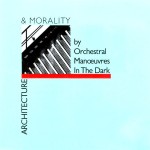 Orchestral Manœuvres In The Dark – Architecture + Morality | 1981 – 4
Orchestral Manœuvres In The Dark – Architecture + Morality | 1981 – 4
[continued from previous post]
“Sealand” was an austere epic for this band. Faint boatwhistle synths with Malcolm Holmes sturdy, unaffected heart beat rhythm while mournful organ chords set the scene for the extremely minimal lyric content. Which would not appear until halfway into the nearly eight minute song. It began as a tone poem of solitude and isolation until the instrumental spell was broken by the appearance of McCluskey at the 3:35 mark.
The minimalism of the song was in direct contrast with its length. Many 7:47 songs were closer to prog opii by default than pop songs, and although OMD certainly had prog roots with their boyhood band Equinox, the arid simplicity of this song set a somber mood without and recourse to overplaying or flashy musicianship. This music has vast gulfs of space between its simple components. When a percussive synth riff set to a simple square wave pattern appeared suddenly at 5:41 the effect was startling,but in just 20 seconds it had faded as the slow chords of the song’s heartbreaking coda had the audacity to employ Mellotron® chords!
 For those who don’t know, the Mellotron was an early precursor to a sampling keyboard that used tape loops of strings that were activated mechanically by a keyboard. It was a feature of many a prog album and gained huge notoriety with early boosters being The Moody Blues, The Beatles, and King Crimson. It was an orchesatra in a box… sort of. I think it’s safe to say that I had not heard a Mellotron on any record since 1975, and when OMD rehabilitated this dinosaur in a Post-Punk context, it was startling to these ears. Andy McCluskey claimed that the limitations of their cheap monosynths led them to giving the polyphonic devices [then dimes on the dollar] a try in order to build up their soundstage to something wider.
For those who don’t know, the Mellotron was an early precursor to a sampling keyboard that used tape loops of strings that were activated mechanically by a keyboard. It was a feature of many a prog album and gained huge notoriety with early boosters being The Moody Blues, The Beatles, and King Crimson. It was an orchesatra in a box… sort of. I think it’s safe to say that I had not heard a Mellotron on any record since 1975, and when OMD rehabilitated this dinosaur in a Post-Punk context, it was startling to these ears. Andy McCluskey claimed that the limitations of their cheap monosynths led them to giving the polyphonic devices [then dimes on the dollar] a try in order to build up their soundstage to something wider.
Side two presented a paradox when I first bought this album. The first two songs were both called “Joan Of Arc.” I wondered what this implied when I first heard the release. I quickly found out that they were two completely different songs and not just a remix situation. The first version was the second single from the album and began with more spectral choral tapes. It seemed like a seven second loop of choral sound was repeating so this pointed to the choral voices loaded into the Mellotron. Then a delicate glockenspiel soon gave way to a sturdy marching beat as McCluskey pondered the mystery of Saint Joan for the first time on side two of the album. The bass synth eventually joined in as the synths entered on the second verse. McCluskey was a model of restraint throughout the song with his passion erupting only on the fifth and final verse. As with most early OMD songs, there was no lyrical chorus. Then the song faded down all elements save for the drum beat, glockenspiel, and the Mellotron chorus; back to guide us to Saint Joan one more time.
Next: …The Saint So Nice They Sang It Twice







![Rock GPA: Orchestral Manoeuvres In The Dark [part 77]](https://postpunkmonk.files.wordpress.com/2023/12/omd-2023-black-red-andy-paul.jpg?w=200&h=200&crop=1)
![Forty Years Ago Today, Simple Minds Changed Everything with "New Gold Dream [81,82,83,84]"](https://postpunkmonk.files.wordpress.com/2022/09/new-gold-dream-in-spotlights.jpg?w=200&h=200&crop=1)
![Nits Enthrall For Their Golden Jubilee Concert At Royal Theatre Carré [part 2]](https://postpunkmonk.files.wordpress.com/2024/04/nits50-stage-2.jpg?w=200&h=200&crop=1)
I’m really enjoying the thoroughness and depth of these OMD posts. I too was hooked by the early albums, and like you my first introduction was the “frankensteined” US compilation album. The first three UK releases hold a special place for me that very few other albums share. I mentally separate them from Crush-era OMD so as not to dilute their brilliance in my own mind. (Dazzle Ships took a bit to grow on me but now I hold it almost at the same level, and I like much of Junk Culture, but “So In Love” was a turning point on my view of them.)
Naive question: What does GPA stand for?
LikeLike
MathManDan – Depth? I wish I had the time for depth. I feel like I’m racing through this thread with little or no time other than hacking down a first draft in the allotted lunch hour, but thanks for your generous words. Hopefully, this thread will bear some good writing eventually.
This may be an American thing, but a G.P.A. is a Grade Point Average. Where [and when] I was in school, there was a five point grade average. Fail=0, D=1, C=2, B=3, and A=4. On a report card, every class was assigned one of the five grades. To formulate your G.P.A., one added up the numerical sum they made according to that scale and divided by the number of classes taken to get the G.P.A.
LikeLike
Silly me, I wasn’t thinking of the albums being “graded” in the school GPA sense, I was thinking GPA must be some other acronym I wasn’t aware of. My own brain fart, carry on!
I’m in the U.S. also, and grew up an hour from LA. We had this radio station KROQ that, back then, played all the music discussed here. If you Google their top 100 from 1981, for instance, you’ll get an idea. OMD’s Electricity was 23. I credit that station for exposing me to all this (and curse them for making me obsessed).
LikeLike